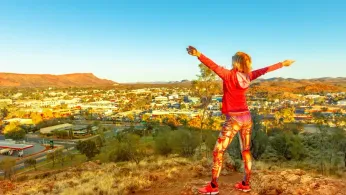
4 hours ago
Alice Springs: Australia’s Red Centre Rises as a Hidden Queer Haven
READ TIME: 4 MIN.
Alice Springs, tucked between ochre cliffs and sprawling desert skies, isn’t the first place most queer travelers look for community and celebration. Yet, in recent years, this remote town in the Northern Territory has quietly become one of Australia’s most welcoming—and surprising—destinations for LGBTQ+ visitors. With its dynamic FABalice Festival, strong local queer networks, and a culture shaped by Indigenous, artistic, and activist voices, Alice Springs offers a fresh alternative to the urban scenes of Sydney or Melbourne .
The heart of Alice Springs’ queer renaissance is the annual FABalice Festival, a weekend-long celebration inspired by the cult classic "The Adventures of Priscilla, Queen of the Desert," much of which was filmed in and around the Red Centre. The festival, held each March, brings drag queens, cabaret artists, transgender people, and allies together for a dazzling program that includes street parades, lip-sync battles, art exhibitions, and dance parties. It’s not just a party—it’s a tribute to the region’s history as a site of both struggle and celebration for LGBTQ+ Australians .
Local organizers emphasize the festival’s role in fostering visibility and connection. “FABalice is about creating a space where everyone feels seen and safe, regardless of identity,” said one committee member in a recent interview with the ABC, noting the importance of rural pride events for those isolated by geography or stigma .
Alice Springs hosts a surprisingly active and welcoming queer community, with support groups, social nights, and advocacy led by organizations such as Headspace Alice Springs and the local branch of Rainbow Territory. These groups provide vital resources for LGBTQ+ youth and adults, including mental health support, social meetups, and training for businesses on inclusive practices .
The town’s cafes, galleries, and live music venues reflect this diversity. Page 27 Café, a local favourite, hosts regular queer nights and art shows featuring LGBTQ+ creators. Epilogue Lounge offers open mic events and drag performances, while the Araluen Arts Centre often collaborates with FABalice to showcase queer artists and storytellers .
Local voices highlight the unique experience of being queer in the outback. “There’s something special about building community here,” says Jade, a non-binary artist and festival volunteer. “It’s intimate, it’s creative, and people genuinely look out for each other. You’re not anonymous—you’re embraced” .
What sets Alice Springs apart isn’t just its queer-friendliness, but the intersection of LGBTQ+ and Indigenous cultures. The region is a hub for Aboriginal art, and many local galleries—including the acclaimed Iltja Ntjarra Many Hands Art Centre—feature works that explore themes of identity, resistance, and belonging. During FABalice, Indigenous LGBTQ+ voices are central, with storytelling sessions and performances that honor the “Sistergirls” and “Brotherboys”—terms used by Aboriginal transgender women and men .
This blend of cultures creates a sense of solidarity and shared celebration. Many festival events are held in partnership with local Indigenous organizations, and workshops explore topics from queer history in the Territory to the art of bush drag. The result is a festival—and a community—that feels genuinely inclusive and culturally rich.
Several factors are driving Alice Springs’ rise as a queer-friendly destination:
- Authenticity: Visitors are drawn to the town’s laid-back, genuine atmosphere. Unlike larger cities, Alice Springs offers intimate gatherings, accessible events, and opportunities to connect directly with locals .
- Visibility: The FABalice Festival and year-round activism have made LGBTQ+ identities more visible and accepted throughout the town, encouraging both locals and visitors to express themselves freely .
- Support Networks: Strong community groups and local businesses work together to ensure queer travelers feel safe and supported, offering resources and recommendations for everything from nightlife to health services .
- Natural Beauty: The surrounding MacDonnell Ranges and nearby national parks add adventure, with guided walks, cycling trails, and stargazing nights popular among LGBTQ+ travelers seeking connection to nature .
Alice Springs boasts several accommodations that welcome LGBTQ+ guests, such as the quirky Alice Springs YHA—housed in a converted movie set—and eco-friendly bed and breakfasts run by queer owners .
Highlights for queer visitors include:
- The Todd Mall: Home to galleries, boutiques, and weekend markets, often featuring queer artists and vendors .
- Olive Pink Botanic Garden: A tranquil spot for picnics, nature walks, and occasional storytelling events.
- Drag Under the Stars: Outdoor drag shows held during FABalice at local parks, drawing crowds from across the region.
- Bushwalks and Outback Adventure: Guided hikes into the West MacDonnell Ranges with LGBTQ+ friendly tour operators.
- Queer Film Nights: Screenings of classic and new LGBTQ+ cinema at the Alice Springs Cinema and Araluen Arts Centre.
While Alice Springs is increasingly queer-friendly, rural and remote communities still face barriers—from limited resources to lingering social stigma. Organizers stress the importance of continued advocacy and allyship, particularly for transgender people and queer Indigenous Australians .
Despite these challenges, the energy in Alice Springs is one of hope and momentum. Each year, FABalice grows in size and ambition, and local businesses, schools, and artists increasingly weave LGBTQ+ inclusion into their everyday practices .
For LGBTQ+ travelers seeking a destination beyond the expected, Alice Springs offers a rare combination of acceptance, creativity, and community spirit. It’s a place where drag queens can strut beneath desert stars, Indigenous and queer histories are celebrated side by side, and strangers become friends over coffee, art, and adventure.
Here, every visitor can find both a sense of belonging and the thrill of discovery—a true hidden gem in Australia’s Red Centre.






